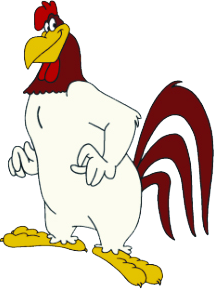
Bugs Bunny is a fictional character created in the late 1930s at Warner Bros. Cartoons and voiced originally by Mel Blanc. Bugs is best known for his featured roles in the Looney Tunes and Merrie Melodies series of animated short films, produced by Warner Bros. Earlier iterations of the character first appeared in Ben Hardaway's Porky's Hare Hunt (1938) and subsequent shorts before Bugs's definitive characterization debuted in Tex Avery's A Wild Hare (1940). Bob Givens, Chuck Jones and Robert McKimson are credited for defining Bugs's design.

Looney Tunes is an American animated comedy short film series produced and distributed by Warner Bros. The series originally ran from 1930 to 1969, concurrently with its partner series Merrie Melodies, during the golden age of American animation. Following a revival in the late 1970s, new shorts were released as recently as 2014. The two series introduced a large cast of characters, including Bugs Bunny, Daffy Duck, and Porky Pig. The term Looney Tunes has since been expanded to also refer to the characters themselves.

Porky Pig is an animated character in the Warner Bros. Looney Tunes and Merrie Melodies series of cartoons. He was the first character created by the studio to draw audiences based on his star power, and the animators created many critically acclaimed shorts featuring the character. Even after he was supplanted by later characters, Porky continued to be popular with moviegoers and, more importantly, the Warners directors, who recast him in numerous everyman and sidekick roles.

Hanna-Barbera was an American animation studio and production company that was active from 1957 until it was absorbed into Warner Bros. Animation in 2001. It was founded on July 7, 1957, by William Hanna and Joseph Barbera following the decision of Metro-Goldwyn-Mayer (MGM) to close its in-house cartoon studio, and was formerly headquartered on Cahuenga Boulevard from 1960 until 1998 and at the Sherman Oaks Galleria in Sherman Oaks, both in Los Angeles, California.

Tiny Toon Adventures is an American animated television series created by Tom Ruegger that was broadcast from September 14, 1990, to December 6, 1992. It was the first animated series produced by Steven Spielberg's Amblin Television in association with Warner Bros. Animation. The show follows the adventures of a group of young cartoon characters who attend Acme Looniversity to become the next generation of characters from the Looney Tunes series.

Terrytoons was an American animation studio in New Rochelle, New York, that produced animated cartoons for theatrical release from 1929 to 1973. Terrytoons was founded by Paul Terry, Frank Moser, and Joseph Coffman, and operated out of the "K" Building in downtown New Rochelle. The studio created many cartoon characters including Fanny Zilch, Mighty Mouse, Heckle and Jeckle, Gandy Goose, Sourpuss, Dinky Duck, Little Roquefort, the Terry Bears, Dimwit, and Luno; Terry's pre-existing character Farmer Al Falfa was also featured often in the series.

Bosko is an animated cartoon character created by animators Hugh Harman and Rudolf Ising. Bosko was the first recurring character in Leon Schlesinger's cartoon series and was the star of thirty-nine Looney Tunes shorts released by Warner Bros. He was voiced by Carman Maxwell, Johnny Murray, and Billie "Buckwheat" Thomas during the 1920s and 1930s and once by Don Messick during the 1990s.

Robert Emerson Clampett Sr. was an American animator, director, producer and puppeteer best known for his work on the Looney Tunes animated series from Warner Bros. as well as the television shows Time for Beany and Beany and Cecil. He was born and raised not far from Hollywood and, early in life, showed an interest in animation and puppetry. After dropping out of high school in 1931, he joined the team at Harman-Ising Productions and began working on the studio's newest short subjects, Looney Tunes and Merrie Melodies.
The New Adventures of Winnie the Pooh is an American animated television series produced by Walt Disney Television Animation. Based on the Winnie-the-Pooh books by authors A. A. Milne and E. H. Shepard, The New Adventures was the first time a major Disney character headlined an animated, made-for-television series as well as the first Disney television series based on a major animated film. The cartoon premiered with a limited run on The Disney Channel on January 17, 1988. Nine months later, the show moved to ABC as part of their Saturday morning lineup. New episodes continued until October 26, 1991. Proving popular with children and older fans, it remained on television in the United States for nearly two decades.
While the history of animation began much earlier, this article is concerned with the development of the medium after the emergence of celluloid film in 1888, as produced for theatrical screenings, television and (non-interactive) home entertainment.
Daniel A. Haskett is an American veteran animator who, according to Variety, was one of a "group of young animators trained by Disney's 'Nine Old Men' that were confined to one small room in the Disney Feature Animation Building in the 1970s."

Xilam is a French production company which specializes in making animated television series and feature films. Marc du Pontavice and his wife Alix founded it in 1999 as a replacement for the animation division of Gaumont Multimédia. Gaumont continued to have a deal with Xilam until 2003. Gaumont Multimédia was a video game publisher until closing in 2004.
Jetlag Productions was an American animation studio that has created a number of animated films based on both popular children's stories and original productions. Produced mainly for the American market, the films were animated in Japan by KKC&D Asia and Animal Ya among South Korean companies. They were later released directly to VHS through the GoodTimes Home Video distribution company.

Foghorn Leghorn is a cartoon rooster who appears in Looney Tunes and Merrie Melodies cartoons and films from Warner Bros. Animation. He was created by Robert McKimson, and starred in 29 cartoons from 1946 to 1964 in the golden age of American animation. All 29 of these cartoons were directed by McKimson.

Animaniacs is an American animated comedy musical television series created by Tom Ruegger for Fox's Fox Kids block in 1993, before moving to The WB in 1995, as part of its Kids' WB afternoon programming block, until the series ended on November 14, 1998. It is the second animated series produced by Steven Spielberg's Amblin Entertainment in association with Warner Bros. Animation, after Tiny Toon Adventures. It initially ran a total of 99 episodes, along with a feature-length film, Wakko's Wish. Reruns later aired on Cartoon Network from 1997 to 2001, Nickelodeon from 2001 to 2003, Nicktoons from 2003 to 2005, and Discovery Family from 2012 to 2014.

Secret Mountain Fort Awesome is an American animated television series created by Peter Browngardt for Cartoon Network that debuted in 2011. The show revolves around a fraternity of five monsters who unleash wild stunts upon the public from their eponymous underground mountain fort.

Roger Rabbit is an animated anthropomorphic rabbit. The character first appeared in author Gary K. Wolf's 1981 novel, Who Censored Roger Rabbit? In the book, Roger is second banana in a popular comic strip, "Baby Herman". Roger hires private detective Eddie Valiant to investigate why his employers, the DeGreasy Brothers, have reneged on their promise to give Roger his own strip. When Roger is found murdered in his home, Valiant sets out to look for the killer, with the help of Roger's "doppel".
Arthouse animation is a combination of art film and animated film.













